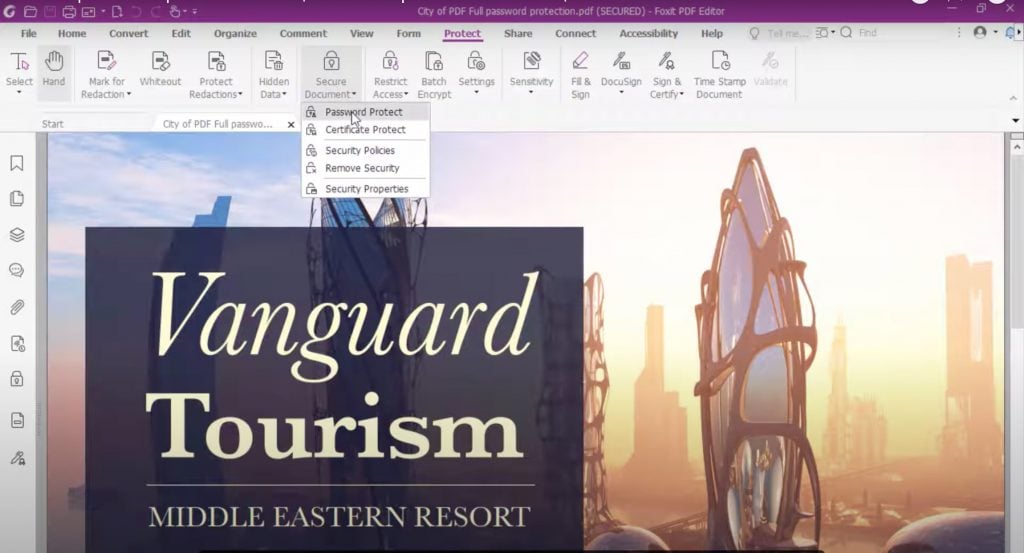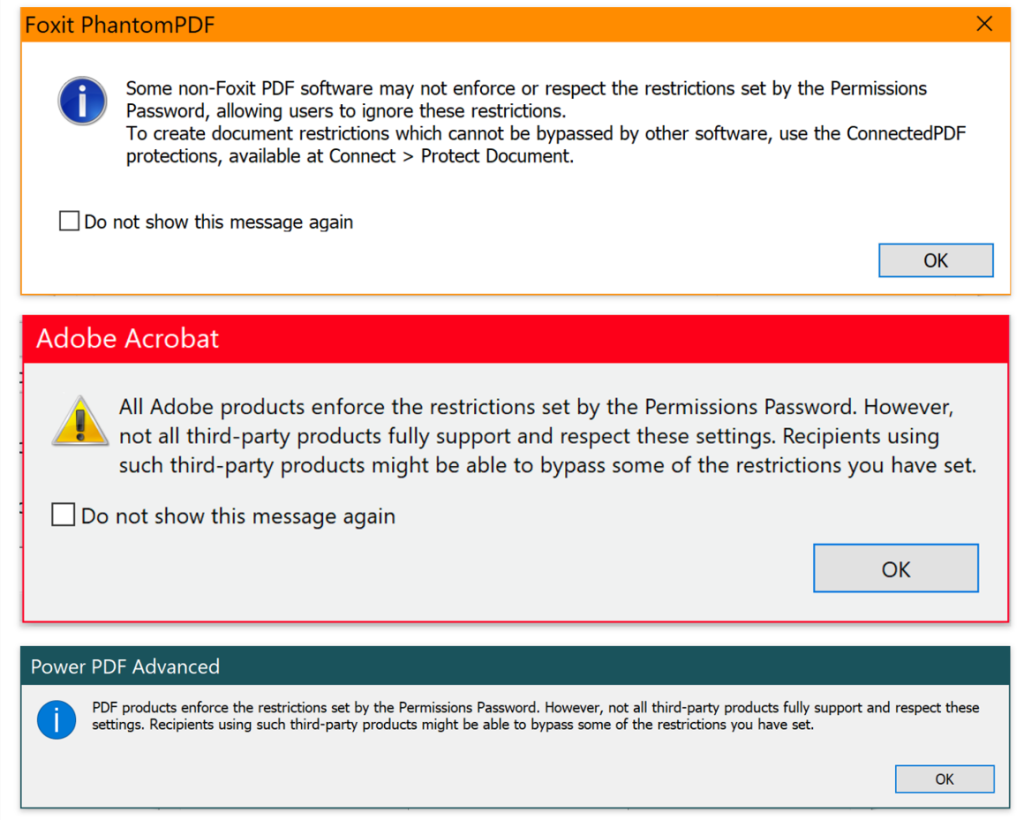- August 16, 2021
- Brad Selbst, Sales Vice President

How to Password Protect a PDF
By password-protecting your PDF file, you’re using a form of encryption. What that means behind the scenes is that the PDF editor software you’re using, such as Foxit PDF Editor, employs a mathematical key to scramble the information in your encrypted PDF file so it can’t be viewed.
Only when someone inputs the correct password will the document decrypt and be put back into its original, viewable format.
Foxit PDF Editor makes password-protecting your PDF file pretty straightforward. You can add, change or remove a password, and you can limit the actions users are allowed to take, such as editing, printing, or sharing your protected PDF.
How to Password Protect a PDF file
To password-protect a PDF, you can follow these steps:
Open the PDF file using a PDF viewer or editor that supports password protection. Some popular choices include Foxit PDF Editor, Adobe Acrobat, PDFelement, and Nitro PDF.
In the application, go to the File menu and select Open to open the desired PDF file.
Once the PDF file is open, go to the File menu again and choose Protect or Security (names may vary depending on the application).
In the protection options, select Encrypt with Password or a similar option.
A dialog box will appear asking you to enter a password. Choose a strong password that is not easy to guess. Make sure to use a combination of uppercase and lowercase letters, numbers, and special characters.
Re-enter the password in the confirmation field to ensure there are no typing errors.
Once you have entered the password, click “Apply” or “OK” to save the password protection settings.
Save the PDF file with password protection by selecting “Save” or “Save As” in the “File” menu.
Now your PDF file is password-protected. When someone tries to open it, they will be prompted to enter the password you set. Make sure to remember the password, as there is usually no way to recover it if it is forgotten.
How to password protect a PDF with Foxit PDF Editor
- Choose Secure Document > Password Protect, or click Properties > Security, and choose Password Protection from the drop-down list.
- In the Password Protection dialog box, select the choices you want and set the password.

For further control over what actions users can take with your document make sure to take advantage of user permissions.
To add passwords that restrict user permissions such as printing, editing, copying, etc., select Add Document Restriction and set the password. Then select Restrict printing and editing of the document and its security settings in the Permission Settings dialog box and choose from the following:
- Printing Allowed – enables you to choose the level of printing that users are allowed.
- Low resolution – allows users to print at no higher than 150-dpi resolution.
- High resolution – allows users to print with any resolution.
- Changes Allowed – defines which editing actions are allowed in the document.
- Inserting, deleting, and rotating pages – allows users to insert, delete, and rotate PDF pages.
- Filling in forms and signing existing signature fields – allows users to fill in forms and sign documents in existing signature fields.
- Commenting, filling in forms, and signing existing signature fields – allows users to add comments, fill in forms and sign documents in existing signature fields.
- Any except extracting pages – allows users to do anything except extract pages.
- Enable copying of text, images, and other content – allows users to copy content in PDFs.
- Enable text access for screen reader devices for the visually impaired – allows the visually impaired users to access text with screen reader devices.
Note: There’s no way to recover password from the PDF if you forgot it. Keeping a backup copy of the PDF that isn’t password-protected is a good choice.
How to remove password protection from a PDF document using Foxit PDF Editor
(NOTE: To remove password and security settings from a PDF, you must have permission to do so.)
To remove a password from a PDF document, you can follow these steps:
- Open the PDF document in Foxit PDF Editor. If you don’t have Foxit PDF Editor, you can download and install it from the Foxit website.
- Choose either of the following to remove password and security settings.
- Choose Protect > Secure Document > Remove Security.
- Choose Protect > Secure Document > Security Properties, or choose File > Properties. In the Security tab for the document properties, choose No Protection from the Security Method menu.
- A Foxit Security message box will prompt you to ask whether you are sure you want to remove security from this document.
- If the document has a Document Open password, click OK to remove it from the document.
- If the document has a permissions password, enter the password in the Enter Password box then click OK.
- After removing the security, save the PDF document to apply the changes.
You can also use online services to remove the password from your PDF document.
Please note that removing the password from a PDF document may be subject to legal restrictions or require appropriate permissions to remove security it. Make sure you have the right to remove the password.
That’s how to remove password from PDF. Now that you know how password-protected PDF documents can be foiled, you may want a higher level of protected PDF.
Now that you see how easy it is to alter a password protected PDF, here are more secure ways to protect your PDFs
Here’s how to protect your PDFs from being accessed by software that bypasses password protection.
You may have seen this message if you’ve used reputable PDF creator software such as Adobe Acrobat or Foxit PDF Editor.

It’s displayed by all PDF creation software that adheres to ISO standards. If you don’t remember this warning, it’s likely that you told the software to stop showing it.
You’ll only see this again if you change PDF software, like switching to Foxit PDF Editor.
This pop-up message is a warning about using non-ISO-compliant software
This pop-up warns you to be careful if you, or anyone in your company, uses non-ISO-compliant software. If you use non-ISO-compliant PDF software, the software may break your password restrictions on password-protected PDF documents.
It’s a worst-case scenario. Foxit hasn’t seen non-ISO PDF software decrypt documents, but we have seen products that can change the document’s tags.
What should you do? Choose the appropriate password strength and level of security. Here’s a quick guide.
What level of security do you require for your PDF documents?
Three methods are available to protect PDF files. This is how they compare.
Password Protection for PDF password security
Password protection is the simplest security method used of protecting documents. It’s a single level of encryption. No third party is involved, and no corporate verification. The PDF is the only thing that generates encryption and allows it to be decrypted. Anyone with a password can access the encrypted PDF file.
Regarding document security, password protection is a good option for the basics. As you’ve seen, however, it’s relatively easy to remove password security. If you want to go beyond password protected or PDF encrypted documents, then AIP and/or certificate signatures are the best options.
Certificate protection goes beyond password protection
To protect a PDF at a higher level, you can turn to certificate protection. Certificate signatures are also known as digital certificates.
Foxit is ISO-certified, so we support third-party certification. Foxit PDF Editor will verify the identity of the person who enters their username and password by pinging the Windows ID or any other third party associated with the certificate.
Rights Management goes beyond certificate protection or PDF password security
Azure Information Protection, also known as AIP, is the third level of security for PDF documents. This Microsoft Windows security software provides data protection throughout the enterprise by automatically enforcing policies for data access. Foxit supports AIP.
AIP, created by IT professionals in your company, allows you to develop directories with a hierarchy within them of people who can access the documents being produced. Depending on department, group, or individual, they may also be granted different permission levels.
If you work in the marketing department at Acme Software Corporation, you could set up an AIP directory that allows Steve and his product team to make changes to your documents. Yet, only Stephanie and her accounting department can print them.
When you log in to the system with your corporate ID (on-site or remotely), your AIP will activate automatically. Foxit PDF Editor allows you to access the documents, then decrypt and apply AIP.
You can now choose between different levels of document security
You can see that the pop-up mentioned above is not something to be concerned about. However, you should pay attention because it alerts you that PDF software and document protection differ regarding document security. Choose the level that best suits your needs.
Didnt work… Images here are not the same as my Foxit program…
Hi Mario, could it be your using Foxit PDF Reader? This article is about Foxit PDF Editor.